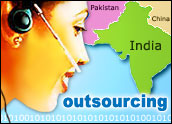
Indian call centers are being purchased by U.S. and Canadian companies seeking to quickly gain access to call center services offshore, particularly outbound services. Although media attention focuses more on the sale of U.S. assets to Asian and Middle Eastern firms, this trend in the other direction highlights how globalization is linking economies, consumers and businesses around the world.
Here we examine why Indian call centers are being bought by Westerners, what is being purchased, and how the transitions function. The focus is on providing advice for potential buyers. A follow-up piece will provide cost data and management advice.
“Three or four call centers per month are being sold in Bangalore to Americans and Canadians,” said Kiran Upadhya, a Bangalore-based consultant with Uni Solutions who specializes in the construction and management of call centers. Even more popular are lease arrangements that include personnel and all telecommunications costs.
Lease arrangements that include personnel are called “wet leases.” Leases without personnel are called “dry leases.” According to Upadhya, North Americans are taking out wet leases for all or part of five to six call centers per month in Bangalore.
Buyouts Focus on 70-80 Seaters in Bangalore
The size of centers being sold ranges between 50 and 100 seats, with 75 to 80 seats being the most common. Call centers in the range of 20 to 30 seats are not being sold to Westerners because these facilities are usually not worth the effort to acquire.
“Most of these facilities with less than 30 seats are just selling grants or credit cards,” said Upadhya, programs that he characterizes as worthless. “Call centers with 75 to 80 seats can have better programs that add value to a facility being sold,” he added. Westerners are buying Bangalore call centers primarily for conducting outbound work.
“Bangalore is an attractive location for buying call centers because the agent pool has better accents than agents in the National Capital Region,” Upadhya said, “although agents in the Capital Region are more aggressive, tenacious sellers.” The National Capital Region, or NCR, includes New Delhi and the neighboring satellite towns of Faridabad and Gurgaon (both in Haryana), and the Uttar Pradesh metropolitan areas of Noida and Ghaziabad.
Bangalore offers a unique combination of advantages over alternate locations in India. The atmosphere for women workers is better in Bangalore than in the NCR. Most of the local police in Bangalore speak English, and corruption there is low by Indian standards.
Although Bangalore has a reputation for traffic jams, other Indian metropolitan areas have equal or greater traffic problems. The city’s temperate climate rivals San Francisco’s.
Except for Kolkata, which is seeing a call center boom, new facility setups in India are increasingly headed for second and third tier cities. However, for buying an existing facility, Bangalore is where the action is.
The advantages of buying an existing center are described below by Kurian James, CEO of Manipal Informatics. James is located in the third tier Indian city of Manipal, in the same state as Bangalore.
- “Building a new center involves a massive hiring exercise. Acquisition will bring in a fully functional center that can be adapted to the new processes in less than a month in most typical cases. The existing business that the acquired company already has can be hived off for a tidy profit if the acquiring company does not want to continue this line of business.
“It takes about a year for operations in a new center to settle down, especially when it is in a tier two or tier three city. Buying an existing center in a tier two or tier three city will enable the buyer to acquire an existing business that runs smoothly while taking additional advantage of the lower cost factors. Tier three cities are about 15 percent cheaper than the major hubs like NCR and Bangalore. Centers operating in tier three cities have about 25 percent lower costs.”
Valuations of Indian Call Centers
The acquisitions process for an Indian call center is initially similar to the process of acquiring a firm in the U.S. Buyers need to develop criteria to guide them in selecting the right facility — rather than locking themselves into the first opportunity that comes along. Understanding how to value a business entity is critical in this process, and this is where the process diverges between India and the U.S.
The value proposition for Westerners buying an offshore firm is going to be dramatically different from the way an outsourcing firm in the U.S. is valued for overseas buyers. Buyers need to recognize the value proposition of potential acquisition targets in order to determine how much to pay and whether to make an acquisition at all.
The biggest potential value in buying or wet leasing an Indian call center comes from the personnel. An intact team of call center agents with more than 18 months of experience represents a huge investment in time and money. As reported earlier here, the starting pay for call center agents with no experience is 8,000 Indian Rupees (INR) per month or US$182.
Call center agents can switch to another call center after gaining only three months of experience at their first job. They will often switch to another center for just INR 1,000 (less than $23) in additional salary per month.
Turnover rates in excess of 100 percent per year are not uncommon at some call centers. Two or three people can leave facilities in the 50 to 200 seat range each day. With such high turnover rates, it becomes difficult for employers to conduct background checks on potential employees, thereby encouraging call center fraud.
When a call center picks up a new campaign, the facility’s human resources (HR) department is often tasked with recruiting and providing initial training for 10 to 40 new agents. If they screen out more than 25 percent of the new recruits, then the center may not have enough staff to launch the campaign, thereby generating pressure on trainers to not weed out too many agents. Postponing the outplacement of poorly recruited staff may slow turnover but not eliminate it.
“A call center with 40 or more experienced agents can be of tremendous value for a buyer,” said Upadhya. “At an older call center, workers will be happy to now be working for a Western firm, especially if given a 20 percent pay increase,” he said, adding, “just give them Friday and Saturday nights off.”
Tax Advantages and Speed to Market
Tax considerations can determine the form that acquisitions take. The tax rule governing Western businesses that have moved software development, customer service, and research and development work to India is Circular 5/2004 and is available here. The circular was issued by the Finance Ministry of India (GOI) on September 28, 2004, and has yet to be fully implemented.
Circular 5/2004 assesses corporate tax rates of about 36 percent on foreign firms and on domestic firms that obtain all their business from a single non-Indian source. By retaining the original Indian corporate entity, Westerners may be able to avail themselves of the exemption provided under that circular for domestic Indian firms. The exemption can be substantiated if the Indian operation continues to accept contracts in India from third parties.
Buying an existing center provides advantages for buyers seeking fast market entry. Buying an existing operation enables buyers to quickly begin using a facility that is under their control.
New facilities can now be set up in six months, compared to two years in 1999 and 2000. However, new facilities commonly experience technical problems that can take months to resolve. Buying an existing unit with stable technology reduces technology risks.
A follow up article will provide management advice and cost data for buying Indian call centers. It seeks to preserve the primary asset value of an established facility, which is its existing staff of experienced agents.
Anthony Mitchell , an E-Commerce Times columnist, has beeninvolved with the Indian IT industry since 1987, specializing through InternationalStaff.net in offshore process migration, call center program management, turnkey software development and help desk management.
















































